Last Updated on May 11, 2022
In the first scene from Amazon’s “The Pursuit of Love,” an air raid disrupts a lazy day of sunbathing and napping for Linda Radlett. A bomb explodes and her bed plummets through the floor with her on it, making her landing “perfectly comfortable,” she giggles to her cousin Fanny.
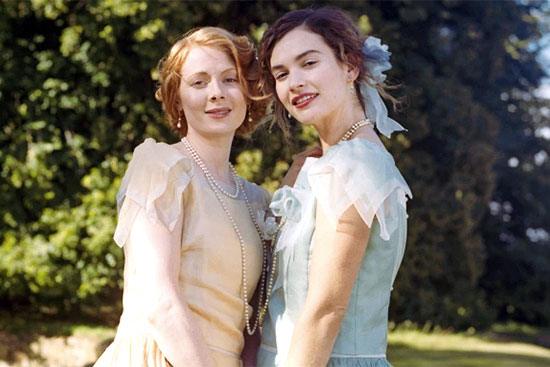
To help keep this site running: Willow and Thatch may receive a commission when you click on any of the links on our site and make a purchase after doing so.
Making the best of a terrible situation could also be said of filming the series during a global pandemic.
Based on Nancy Mitford’s 1945 novel of the same name, the coming-of-age period drama centers on the friendship between the two privileged British young women, played by Lily James and Emily Beecham, growing up between the wars.
As one of the first television series to begin filming since the start of the pandemic in the UK, “The Pursuit of Love” had to adapt to a new reality of closed sets, endless nasal swabs, and strict masking. Covid also limited the sites open to filming, forcing the team to use the same locations for multiple scenes, but you’d never know it.
Lacock Abbey stood in not only for Tony Kroesig’s rooms at Oxford but for Fanny’s home, as well. Dyrham Park’s rooms were transformed into Linda’s communist bookshop and its ballrooms witnessed Louisa, Fanny, and Linda’s coming out balls. The gardens hosted several outdoor scenes and doubled as a cafe in Rome. But while Covid certainly impacted filming, production’s clever and economical use of locations –and a dash of cinema magic– mean that the viewer doesn’t notice.
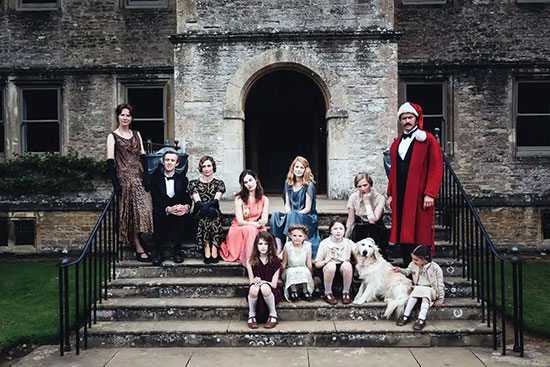
Two properties, in particular, are the backbone of the series. Rousham House is the emotional anchor as the Radlett family home; Badminton House is a supporting player whose sheer size and visual interest enable it to stand in for multiple locations.
Rousham House in Oxfordshire bears the emotional weight of the series as the Radlett family home, Alconleigh. Built in 1635 and remodeled in the Gothic style in the 18th century, it has the feeling of a castle, one from which the Radlett children long to escape. Though it confines the family at the beginning of the series, by the end, the now-grown children return to its protection to ride out the war and have their babies.
Executive Producer Charles Collier says of the house, “We needed something that was a fabulous hotchpotch, that looked like Uncle Matthew’s private lair, fortified and slightly forbidding, but also had the other side of his personality, of a man who loved his children.” Rousham House, rarely seen on film, fit the bill.
Director Emily Mortimer used the house for both interior and exterior shots, most notably for the continuous shot of Fanny arriving for Christmas at the beginning of episode 1. Mortimer told Town & Country, “It was so important for people to move through the rooms. I wanted to have a journey from the front door, coming up the steps, through the hallway into the dining room. And then for Linda to run out of the dining room and go up the stairs and along the corridor and into the cupboard. I really wanted to feel like you, the audience, knew the nooks and crannies and the spaces of that Radlett house.”
The filming style makes you feel as though you’re careening around the house just behind Linda, as if you are practically a Hon, yourself.
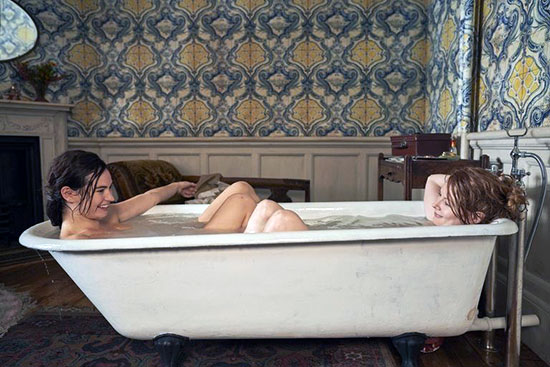
The bathroom in which Fanny and Linda have some of their most intimate conversations, however, is a set. Production recreated an actual Rousham bathroom, complete with blue and yellow wallpaper, on a soundstage, sparing the real wooden floor from floods of Linda’s bathwater.
The other structural anchor of the series is Badminton House, which stood in for an improbable number of locations. Its gardens, covered in fake blooms, became the sterile garden of Tony Kroesig’s family. The grounds also hosted a Spanish refugee camp, and the pool was the Italian palazzo where the Bolter luxuriates with an aristocratic lover. A hunting room, antlers lining its walls, posed as a room at Alconleigh. A chapel on the estate served as St. Margaret’s, near Westminster Abbey, and the old kitchen as the House of Commons. The sunny south front of the house appears in exterior shots as Lord Merlin’s home, and the North Hall became his “cinema room,” live horses and all.
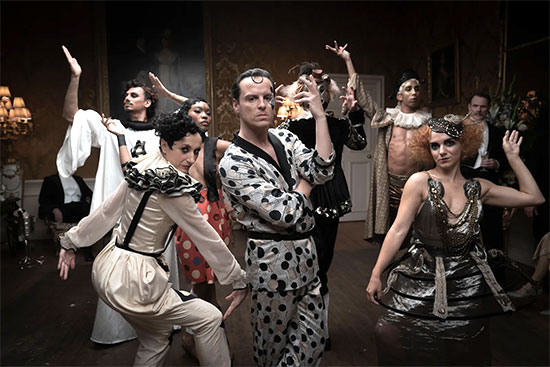
That one house and grounds could serve so many functions is a testament to the inventiveness of production design and to the scale of old English estates.
Badminton House, supposedly where the game originated, became the seat of the dukes of Beaufort in 1682. Like other aristocratic owners of vast estates, many generations of Beauforts made their mark on the family home. Dukes and duchesses of Beaufort employed renowned architects and landscape designers to enhance the house and grounds, adding water features, “follies,” and numerous formal gardens.
Today the extensive estate of 50,000 acres encompasses 20 working farms, and the house can host 800 for drinks. Small wonder, then, that Mortimer found so many staging possibilities at the vast and varied estate.
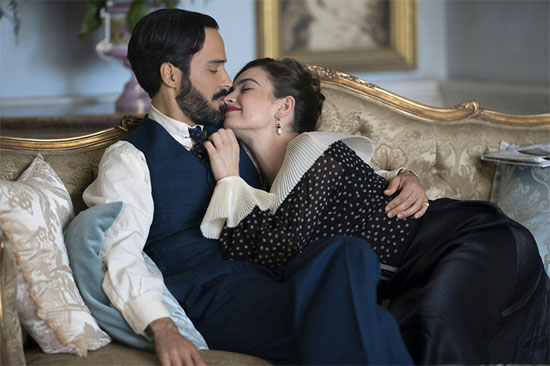
One could argue that Paris should be considered a third key location in the series, and thematically, it is. But although a large part of episode 3 takes place in Paris, Mortimer only filmed in the French capital for a day. Due to health precautions, time constraints, and budget, only the shots of city streets and the Seine are from that day of shooting.
Instead, the interior shots –a nightclub, Linda’s Paris apartment, Brasserie Lipp, and more– were filmed at Stourhead and London’s Savile Club. The Paris Ritz and Linda and Fabrice’s love nest? Badminton House, of course.
“The Pursuit of Love” (2021) is AVAILABLE to STREAM
Read our REVIEW
Watch the TRAILER
Rated 13+
Alyssa Murphy is a freelance writer living in Alexandria, Virginia. She has worked in communications for education, economic independence, and environmental nonprofits and was the editorial manager for a child psychiatry journal. In her free time, she enjoys listening to dramatized Agatha Christie mysteries and studying grand English country houses.
If you enjoyed this post, wander over to The Period Films List. You’ll especially like the Best Period Dramas: Interwar Era List.

